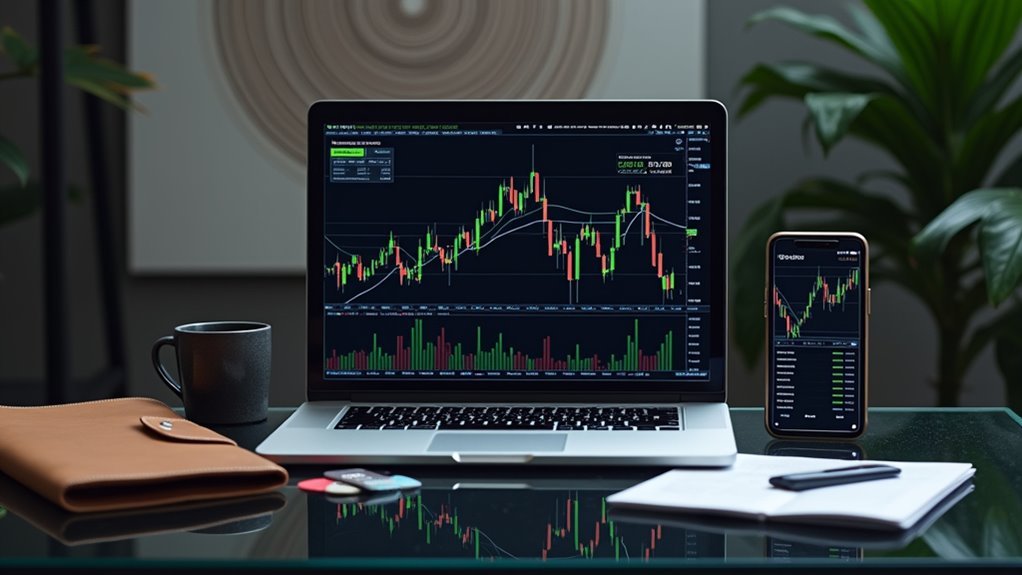Selecting a brokerage platform isn’t rocket science, but it matters. Today’s platforms offer everything from basic stock trading to crypto, with fees ranging from free to painful. Web-based platforms work for casual investors, while desktop software suits active traders who need fancy tools. Research capabilities, educational resources, and customer support vary wildly between brokers. Account minimums and trading costs can make or break the experience. The right choice depends on individual style, goals, and cash flow – there’s more to the story.

While choosing a brokerage platform might seem overwhelming at first, investors today face an abundance of options to meet their trading and investment needs. The modern brokerage landscape has evolved dramatically – gone are the days of sky-high commissions and phone calls to human brokers. Most platforms now offer commission-free stock and ETF trades, which is pretty sweet for the average investor’s wallet.
Account types run the gamut from basic cash accounts to margin accounts for those brave (or foolish) enough to trade with borrowed money. IRAs cater to the retirement-focused crowd, while joint and custodial accounts handle shared and minor’s investments. The investment menu is equally diverse – stocks, bonds, ETFs, mutual funds, and even cryptocurrency for the digital cowboys. Many investors appreciate that competitive rates like 10% margin interest are available for account balances between $50,000 and $99,999. Starting with just small investments can help build long-term wealth through compound growth over time.
Trading platforms come in all flavors. Web-based platforms work for casual investors who don’t need fancy bells and whistles. Serious traders gravitate toward desktop software loaded with advanced features. And yes, everyone has a mobile app these days – because heaven forbid anyone can’t panic-sell during their morning commute. Having easy-to-navigate interfaces ensures traders can quickly execute trades without confusion or delays.
Research tools separate the contenders from the pretenders. Real-time quotes, screening capabilities, and analysis tools are must-haves. Some platforms throw in fancy extras like paper trading accounts – perfect for practicing without burning real cash. The truly ambitious can even access APIs for algorithmic trading, though that’s not for the faint of heart.
Education resources matter, especially for newer investors still learning the ropes. Online courses, webinars, and tutorial videos help bridge the knowledge gap. Support options range from 24/7 chat to actual human beings at physical branch locations – imagine that.
Modern platforms keep adding bells and whistles: fractional shares for small-budget investing, automatic dividend reinvestment, robo-advisors for the hands-off crowd. Some even offer banking services, trying to become one-stop financial shops.
The key is matching these features to individual needs and trading styles. Not everyone needs every feature – and paying for unused capabilities is about as smart as buying a submarine in Kansas.
Frequently Asked Questions
What Happens to My Investments if My Brokerage Platform Goes Bankrupt?
Investments are actually pretty safe if a brokerage goes belly-up. SIPC insurance covers up to $500,000 in securities, including $250,000 in cash.
Plus, brokerages must keep customer assets separate from company funds – it’s the law. Accounts typically transfer to another firm within weeks. Trading might freeze temporarily, but the money doesn’t vanish.
SIPC oversees the whole process to protect investors.
Can I Transfer My Existing Portfolio From One Brokerage to Another?
Yes, investors can transfer portfolios between brokerages using ACATS (Automated Customer Account Transfer Service).
The process typically takes 3-6 business days. Most stocks, bonds, ETFs, mutual funds, and cash are transferable.
Trading freezes during the transfer – tough luck for day traders. Some specialized assets might not transfer.
Watch out for transfer fees from the old brokerage. Many investors do this to snag better fees or tools.
How Long Does It Take to Withdraw Money From My Brokerage Account?
Withdrawal times vary drastically depending on the method.
ACH transfers? 2-3 business days.
Wire transfers complete same-day but cost more.
Paper checks are dinosaurs – taking 5-7 days to arrive.
Instant withdrawals to debit cards exist, with fees of course.
Fresh deposits and unsettled trades need time to clear first.
No instant gratification here.
Bank holidays and weekends? They’ll slow things down too.
Are Brokerage Platforms Regulated by Government Financial Authorities?
Yes, brokerage platforms face heavy regulation.
In the US, the SEC and FINRA keep brokers in check. The SEC enforces federal securities laws, while FINRA handles day-to-day oversight and broker registration.
States also regulate brokers through their own securities authorities.
Internationally, each country has its watchdogs – like the UK’s FCA and Japan’s FSA.
Brokers who mess up? They face serious consequences.
Can I Have Multiple Brokerage Accounts With Different Platforms Simultaneously?
Investors can absolutely maintain multiple brokerage accounts across different platforms. It’s totally normal – and sometimes smart.
Each platform has its own perks: different investment options, tools, and fee structures. Sure, it means more passwords and paperwork to juggle, but the benefits can be worth it.
Plus, there’s that sweet SIPC protection of up to $500,000 per account. Just remember, more accounts equals more tax forms. Fun times.








